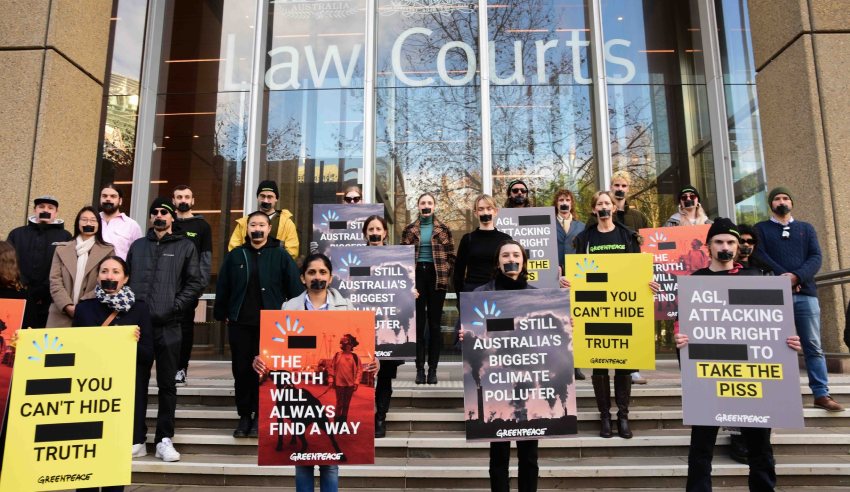Greenpeace and AGL went head-to-head in Federal Court this week following a campaign exposing AGL as Australia’s biggest corporate climate polluter.

The Greenpeace campaign in question used the AGL logo in a “cheeky” way to pressure the company to switch to renewable energy, wherein it labelled AGL as Australia’s biggest climate polluter. AGL has alleged that Greenpeace breached its intellectual property rights by using versions of the AGL logo – and filed a lawsuit against Greenpeace that was heard at Sydney’s Federal Court on Wednesday, 2 June.
The landmark case has been adjourned for the Honourable Justice Stephen Burley to make a judgment over and will have implications for how charities, not-for-profit organisations, comedians and the general public can use corporate logos for the purpose of satire, parody and criticism without facing legal backlash.
AGL requested the Federal Court order the removal of their logos from Greenpeace’s campaign, on the grounds that the use of the logos is an infringement of AGL’s copyright and trademark rights. During the hearing, Greenpeace relied on the fair use defence and the freedom of speech safeguard in the Copyright Act known as “fair dealing” – which allows for freedom of expression and the socially useful purposes of parody, satire, criticism and review.
Greenpeace and other charities and advocacy groups have previously raised concerns about AGL’s use of litigation to stifle the campaign to close its polluting coal-burning operations, with an open letter sent to AGL last week signed by a number of prominent charities, including the Australian Conservation Foundation and 350.org Australia. The letter described AGL’s actions as “an attack on civil society” and a “direct affront to free speech”.
Ahead of the hearing, Katrina Bullock, general counsel for Greenpeace Australia Pacific, said she believes that “the AGL v Greenpeace Australia Pacific intellectual property case shows the manner in which fossil fuel companies use the law in an attempt to intimidate their critics.”
“There has been a growing trend of strategic lawsuits against public participation, or SLAPP suits, which are brought by powerful entities against advocacy organisations or activists, to intimidate and censor them,” she said.
Greenpeace has urged AGL to shut down its coal-burning operations by 2030 and Greenpeace senior campaigner Glenn Walker took the stand on Wednesday to speak about the specifics of the campaign against AGL and the attempt to make the brand “temporarily toxic” so that it might bow to pressure and switch to renewable energy.
Mr Walker spoke about the reasoning behind using satire in the campaign criticising AGL’s greenwashing practices, stating that Greenpeace, as a campaigning organisation with a long history of corporate campaigns, is “famous, both in Australia and internationally” for running parodic and satirical campaigns of this nature against polluting corporations. He also noted that should AGL change its course, the company would be praised and celebrated by Greenpeace.
Acting for AGL, John Hennessy SC argued that a campaign of this nature could be labelled as “educational services” and submitted that Greenpeace sought to profit from the campaign, as well as capitalise on the “originality and popularity” of the AGL logo in an intent to cause damage.
Neil Murray SC, acting for Greenpeace, refuted these claims and emphasised that the not-for-profit is motivated by a desire to protect the environment – and that the campaign had merely drawn attention to the need for AGL to close its coal assets and switch to renewable energy.
“This is not a frolic invented by Greenpeace Australia Pacific. This is a serious issue,” he said.
Mr Murray also drew attention to AGL documents, which show that keeping one of AGL’s coal-burning power stations, Loy Yang A, running until its current 2048 closure date is inconsistent with limiting dangerous global heating to 1.5 degrees.
“The conduct of the campaign to cause people to be critical of AGL for continuing to operate coal until 2048 in the hope that that criticism will create pressure on AGL to change is a legitimate goal: initiating public debate for a beneficial cause,” he said.
“To punish a charity for doing that would be unjust.”

Lauren is the commercial content writer within Momentum Media’s professional services suite, including Lawyers Weekly, Accountants Daily and HR Leader, focusing primarily on commercial and client content, features and ebooks. Prior to joining Lawyers Weekly, she worked as a trade journalist for media and travel industry publications. Born in England, Lauren enjoys trying new bars and restaurants, attending music festivals and travelling.